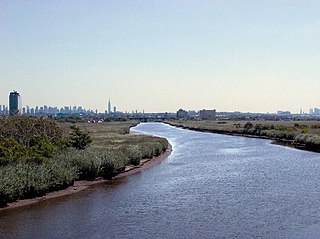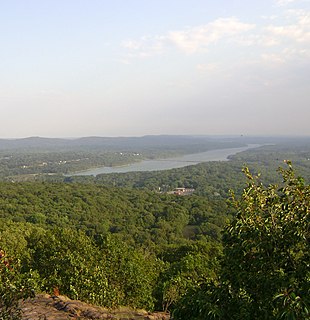
Oradell is a borough in Bergen County, New Jersey, United States. As of the 2010 United States Census, the borough's population was 7,978. The borough includes a dam on the Hackensack River that forms the Oradell Reservoir. Oradell is a suburb of New York City, located approximately 15 miles (24 km) northwest of Midtown Manhattan.

The Hackensack River is a river, approximately 45 miles (72 km) long, in the U.S. states of New York and New Jersey, emptying into Newark Bay, a back chamber of New York Harbor. The watershed of the river includes part of the suburban area outside New York City just west of the lower Hudson River, which it roughly parallels, separated from it by the New Jersey Palisades. It also flows through and drains the New Jersey Meadowlands. The lower river, which is navigable as far as the city of Hackensack, is heavily industrialized and forms a commercial extension of Newark Bay. Once believed to be among the most polluted watercourses in the United States, it staged a modest revival by the late 2000s.

Berry's Creek is a tributary of the Hackensack River in the New Jersey Meadowlands in Bergen County, New Jersey. The creek watershed contains a diverse array of wetlands, marshes, and wildlife. The creek runs through a densely populated region and has been subject to extensive industrial pollution during the 19th and 20th centuries. Several companies discharged toxic chemicals into the creek in the 20th century, and these chemicals have remained in the sediment. The creek has the highest concentrations of methyl mercury of any fresh-water sediment in the world. Portions of the creek watershed are Superfund sites and cleanup projects began in the late 20th century.
The Oradell Reservoir is a reservoir formed by the Oradell Reservoir Dam on the Hackensack River in Bergen County, New Jersey, USA.
New Bridge was a prosperous mill hamlet, centered upon a bridge strategically placed at the narrows of the Hackensack River. In the American Revolution, New Bridge Landing was the site of a strategic bridge crossing the Hackensack River, where General George Washington led his troops in retreat from British forces November 20, 1776. Eleven engagements took place here throughout the war. The current Draw Bridge at New Bridge was installed in 1889 and added to the National Register of Historic Places on July 5, 1989. The area is now a New Jersey historic site in portions of New Milford, River Edge, Hackensack and Teaneck in Bergen County, New Jersey, United States.

New Jersey's 5th congressional district is represented by Democrat Josh Gottheimer, who has served in Congress since 2017. The district contains most of Bergen County, as well as parts of Passaic County, Sussex County, and Warren County.

The Steuben House is a noted example of Bergen Dutch sandstone architecture, located at New Bridge Landing on the Hackensack River in River Edge, in Bergen County, New Jersey, United States.

Oradell is a grade-level commuter rail station for New Jersey Transit in the borough of Oradell, Bergen County, New Jersey. Located at the intersection of Oradell Avenue and Maple Avenue, the station serves trains on the Pascack Valley Line.

The table below includes sites listed on the National Register of Historic Places in Bergen County, New Jersey except those in Closter, Franklin Lakes, Ridgewood, Saddle River and Wyckoff, which are listed separately. Latitude and longitude coordinates of the sites listed on this page may be displayed in a map or exported in several formats by clicking on one of the links in the box below the map of New Jersey to the right.
Hackensack RiverWalk a is partially constructed greenway along the Newark Bay and Hackensack River on the west side of the Bergen Neck peninsula in Hudson County, New Jersey. The eight-mile walkway, following the contour of the water's edge, will run between the southern tip at Bergen Point, where it may connect to the Hudson River Waterfront Walkway, and Eastern Brackish Marsh in the north. Existing parks and promenades have been incorporated and some new sections have been built, but there remain large gaps. There is a RiverWalk in the city of Hackensack, sometimes called the Hackensack RiverWalk, but they are not part of the same project nor are they connected. A parallel walkway on the west banks of the river is known as the Meadow Path.

The Hackensack Water Company Complex is a set of historic buildings in Weehawken, New Jersey, registered in the U.S. National Register of Historic Places. The Hackensack Water Company, a predecessor of Suez North America, developed water supply and storage in northeastern New Jersey from the 1870s to the 1970s, initially to provide service to the city of Hackensack and the towns of North Hudson. Originally its headquarters and major facilities were located at Hackensack, in Bergen County. Under Robert W. de Forest, who ran the Hackensack Water Company for 46 years beginning in 1881, the company constructed new facilities and moved its headquarters to Weehawken in Hudson County, setting up offices in a brick water tower, part of the present complex.

The bridge at New Bridge Landing, New Jersey was built in 1888 to replace an earlier wooden one, and was added to the National Register of Historic Places on July 5, 1989.

The Ford Motor Company Edgewater Assembly Plant was located in Edgewater, Bergen County, New Jersey, United States. The factory began operations in 1930 and was closed in 1955, having been replaced by the Mahwah Assembly plant. The building was built in 1929 and added to the National Register of Historic Places on September 15, 1983, located at 309 River Road. The building was torn down in 2006 and replaced with a residential development.

Van Buskirk-Oakley House is located in Oradell, Bergen County, New Jersey, United States. The house was built in 1834 and was added to the National Register of Historic Places on July 3, 1979.

The Atwood-Blauvelt mansion is a historic residential building built in 1897 and home to the Hiram Blauvelt Art Museum. It is located on Kinderkamack Road in Oradell, Bergen County, New Jersey, in the United States. The mansion is a prominent example of shingle style architecture, which was popular in the United States in the late 19th century. The Atwood-Blauvelt mansion takes its name from original owner, Kimball Chase Atwood, and from its second owner, Elmer Blauvelt who bought it in 1926.

The Court Street Bridge, also known as the Harold J. Dillard Memorial Bridge, is a vehicular movable bridge crossing the Hackensack River between Hackensack and Bogota in Bergen County, New Jersey, which owns it. Located 16.2 miles (26.1 km) from the river mouth at Newark Bay, the swing bridge, which opened in 1908 and underwent major rehabilitation in 2010–2012, is the most-upstream bridge on the river required by federal regulations to open on request.

Lake DeForest, also called DeForest Lake, is a reservoir in Clarkstown, New York, created in 1956 by impounding the Hackensack River, which is a principal part of the water supply for Rockland County, New York and Northern New Jersey, mainly Bergen and Hudson counties. The reservoir is owned and operated by Suez North America, and is the most upstream of its reservoirs along the river's watershed, the others being Lake Tappan, the Woodcliff Lake Reservoir, and the Oradell Reservoir. It has a storage capacity of 5.6 billion gallons. Swimming and bathing are disallowed because the water is reserved for potable use. The lake is traversed by a causeway carrying Congers Road.

Jersey City Reservoir No. 3 is a decommissioned reservoir atop Bergen Hill in the Heights of Jersey City, Hudson County, New Jersey, United States, situated on approximately 13.8 acres (5.6 ha) just south of Pershing Field. It was built between 1871 and 1874 as part of the city's waterworks system designed to provide potable water to the city, including Ellis Island. Its perimeter wall is in the Egyptian Revival style and pump stations are in the Romanesque Revival style. The reservoir provided drinking water until the 1980s, when it was drained and abandoned for a larger reservoir at the Boonton Gorge. Since that time, a mini-ecosystem has taken root behind the thick, 20-foot tall stone walls: trees, wildflowers, swans, great blue heron, peregrine falcons, and at the center a 6-acre lake. This urban wildlife preserve hosts numerous animal and plant species not otherwise found in an urban environment. It was listed on the state and the federal registers of historic places in 2012. Nearby Reservoir No. 1 was located on either side of Summit Avenue and has been demolished.
Easton Tower is a historic building located in Paramus, New Jersey, and originally used as the housing for a water pump on the estate of businessman Edward D. Easton. It was built in 1899 and is located next to the Saddle River at the intersection of Red Mill & Paramus roads.


















